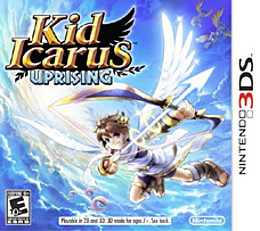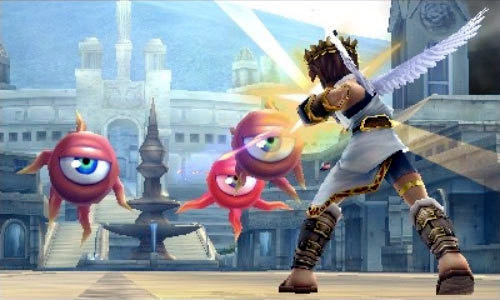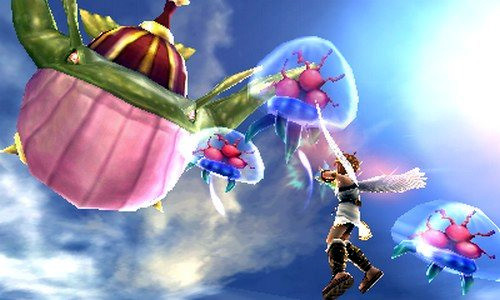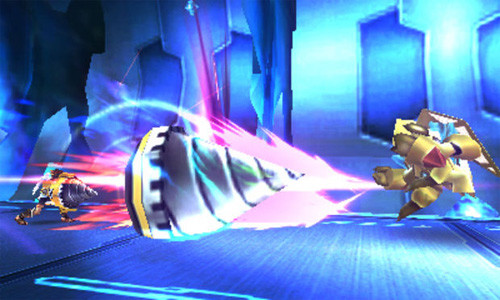Game Review
by Todd Ciolek,Kid Icarus: Uprising
Nintendo 3DS
| Description: |  |
||
Twenty years after the last Kid Icarus, winged hero Pit returns to battle the monstrous hordes of Medusa and other video-game bastardizations of Greek mythology. His journey includes both aerial clashes and castle raids, and he gradually unlocks an extensive arsenal of weapons both ancient and modern. All the while, Pit and Palutena keep up a campy repartee about whatever tangentially related subjects cross their minds. |
|||
| Review: | |||
Perhaps Kid Icarus was never supposed to be a series. The original game was a curious middleweight, a cute but initially brutal exercise in Greek myths run through the video-game logic of 1986. Nintendo seemed content to lay the whole thing to rest after a 1991 Game Boy outing, but Kid Icarus clung to a devoted cadre of fans. Two decades down the road, those fans finally saw the angel-winged warrior Pit reborn, first in Super Smash Bros. Brawl, and then in an all-new game from director Masahiro Sakurai. That Nintendo made a third Kid Icarus is amazing in itself. Even more impressive is that Kid Icarus: Uprising is a marvelously crafted title, one that challenges, punishes, and rewards players in several ways. Requiring no knowledge of the limited Kid Icarus canon, Uprising finds Pit dutifully serving the goddess Palutena in a war against the revived Medusa and her minions. It's not quite that simple, of course: along the way, Pit encounters an evil doppelganger named Dark Pit, a gruff swordsman ally named Magnus (who's almost a parody of beefy fantasy heroes), an evil overlord with a Metroid-ish secret, and all sorts of enemies that recall those of the classic Kid Icarus. And they've grown even more comical with time: the Hewdraw's three heads bicker among themselves, the bloblike Pandora hurls catty insults, and even Medusa doesn't keep a straight face. Most prevalent of all, however, is the banter between Pit and Palutena (and some other deities). The two of them subtly mock the game with a mixture of cornball comedy, surpassing even the likes of Paper Mario in their attacks on the fourth wall.  Uprising is effectively two games. Levels often hurl Pit into an on-rails shooter at first, forcing him to dodge enemy shots and return fire while he's flying through the air (or the twisting depths of a maze). Pit shoots rapidly, but pausing for a while builds up a more powerful shot for him to unleash. After the flying portion of each stage, the game introduces a more substantial on-foot level, where Pit trudges into the depths of an enemy fortress or battleground. The same rules apply to his shots, but his close-range attacks come in handy here for dispatching foes. Pit's also able to dash, dodge enemy shots by a hair's breadth, and grab all sorts of items and power-ups. Unfortunately, these ground levels also bring out the game's biggest problem. In creating a 3-D action title for a handheld like the 3DS, Sakurai went with some strange control options. The default mode has players guiding Pit with the analog pad, firing with a shoulder button, "flicking" the screen to move the camera, and aiming with the touch-screen and stylus. It's an awkward arrangement at first, especially when the game demands that Pit jump gaps or move with precision. Other options prove just as unwieldy when using the directional pad or attack buttons for movement. The game seems perfect for playing with two analog pads, but that's not to be—not even when a second one's attached with the Circle Pad Pro. Still, it's something that must be learned, and it's not hard to grasp the default control arrangement after a few levels of practice.
 And learning those controls is indeed worth the trouble. Uprising is a constantly inventive game, and Sakurai stuffs it with all sorts of clever challenges and side attractions, limited only by Pit's inability to jump freely. Stages brim with good ideas and rarely pad them; Pandora's fortress alone has invisible floors, a tank-racing track, a maze full of trick walls, and a surprise finale. And it's only the fifth of 25 levels. Most of the stage-ending encounters show off the same novelty as typical Mario or Zelda bosses, even if they're over too quickly on the lower difficulty settings. Aside from all of the enemies remade from earlier Kid Icarus stock, Uprising introduces some creative new ones, including the Eggplant Wizard's more cannibalistic counterpart, the Tempura Wizard. There's also plenty to do outside the main thrust of the story. Pit can equip swords, drills, bows, claws, cannons, orbiting shields, staffs, clubs, and certain bare-handed techniques. New weapons pop up constantly, and all of them can be combined into more powerful varieties. There are other uses for the hearts that Pit collects as currency; they can be wagered to increase the game's difficulty level, or they can be offered to Palutena to make her more talkative. There's also the multiplayer mode, where Sakurai mixes his Super Smash Bros. experience with shooter aesthetics to create all enjoyable versus battles.
 Intentionally or not, Kid Icarus: Uprising is a showcase for the 3DS. While the 3-D effect of the system is still distracting at best, Uprising looks quite good all the same; there's almost too much going on visually for a mere handheld. The game also uses the system's AR card feature to full effect, staging battles with the cards and the system's camera. The soundtrack is similarly grand, with RPG-like overtures from Noriyuki Iwadare, Yuzo Koshiro, Masafumi Takada, and Yasunori Mitsuda. Oh, and Motoi Sakuraba, but he's in just about every Japanese game. Uprising spreads itself just as wide in storyline as it does in gameplay. It's a simple plot, but the game delights in doing something silly and twisting it with something even sillier, often when things seem headed for a conclusion. And that's all just fine, because Uprising pitches it all with a carefree tone. Pit and Palutena's back-and-forth is the stuff of cornball cartoons (veteran voice actress Cree Summer even plays Medusa), referencing everything from game mechanics to laser-eye surgery. And there's something adorable about its unfettered camp. Compared to the usual approachable Nintendo creation, Kid Icarus: Uprising demands a lot from players. It might play clumsily at first. It might make you groan aloud at the dialogue (though I hope not). Don't worry. Behind that initially bothersome interface is a magnificent game, and there's plenty of it. There's also a good reason to hope that Nintendo won't make us wait another twenty years for the next Kid Icarus. |
|
The views and opinions expressed in this article are solely those of the author(s) and do not necessarily represent the views of Anime News Network, its employees, owners, or sponsors.
|
| Grade: | |||
Overall : A-
Graphics : B+
Sound/Music : A
Gameplay : A-
Presentation : B+
+ Excellent stage design, enjoyable challenges, stupidly amusing dialogue |
|||
|
discuss this in the forum (21 posts) |
this article has been modified since it was originally posted; see change history |
|||